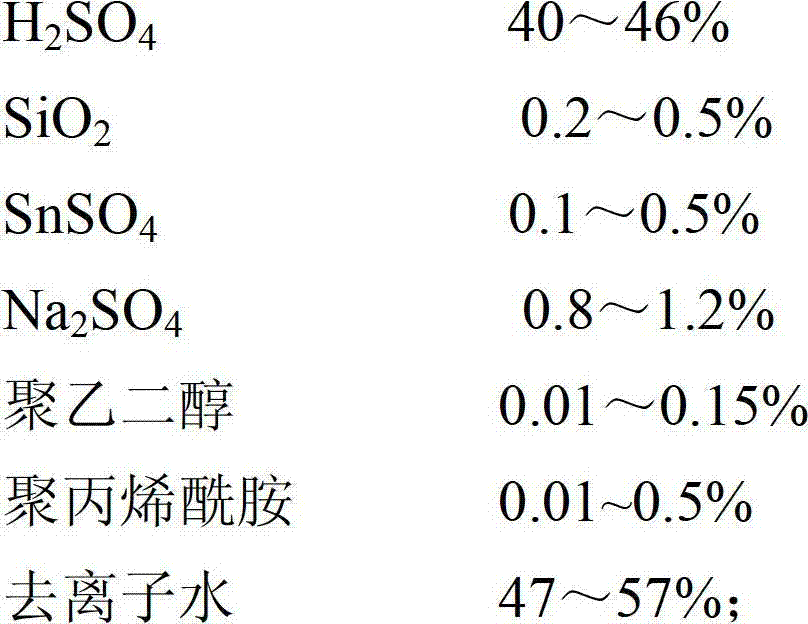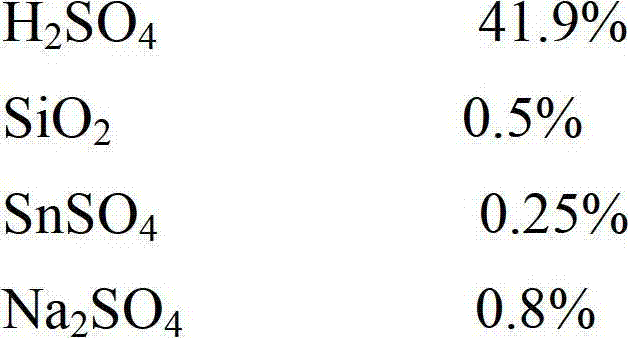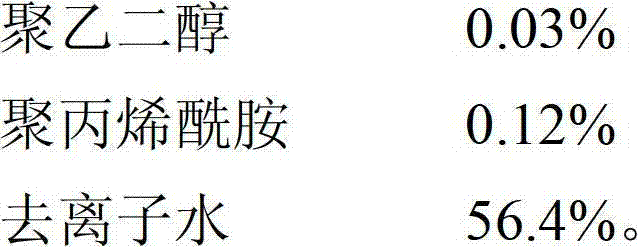Gel electrolyte of power lead-acid storage battery
A technology of lead-acid battery and colloidal electrolyte, which is applied in the direction of lead-acid battery, lead-acid battery construction, semi-lead battery, etc. It can solve the problems of battery heating and expansion, narrow operating temperature range, and battery capacity reduction, and achieve improved discharge performance Effect
- Summary
- Abstract
- Description
- Claims
- Application Information
AI Technical Summary
Problems solved by technology
Method used
Image
Examples
Embodiment 1
[0038] (1) Dissolve 3g of polyethylene glycol and 12g of polyacrylamide with an appropriate amount of water, add deionized water after standing for 30min, heat up to 40°C, stir at 1000r / min for 20min, and cool to room temperature to obtain solution A. A total of 2.82kg of deionized water.
[0039] (2) Mix 2.835kg solution A and 2.82kg deionized water, shear and stir at a speed of 4000r / min and a linear speed of 15m / s for 10min, then add 50g of gas phase SiO while stirring 2 , continue to stir for 30 minutes after the addition is completed, and obtain solution B;
[0040] (3) Stir solution B at a speed of 100r / min, add 4.19kg of sulfuric acid and 25g of SnSO 4 and 80g of Na 2 SO 4 After the addition is complete, continue to stir for 90 minutes, which is worth the electrolyte.
[0041] The above electrolyte was poured into the battery (6-DZM-20), and the internal resistance of the battery was detected to be 12mΩ. The first two-hour rate capacity discharge was 136min, cycle 5...
Embodiment 2
[0043] (1) Dissolve 10% polyethylene glycol and 30g polyacrylamide with an appropriate amount of water, add deionized water after standing for 100min, heat up to 70°C, stir at 1200r / min for 10min, cool to room temperature, and obtain solution A. A total of 2.685kg of deionized water;.
[0044] (2) Mix 2.725kg solution A and 2.685kg deionized water, shear and stir at 6000r / min speed and 30m / s linear speed for 3min, then add 20g of gas phase SiO while stirring 2 , continue to stir for 10 minutes after the addition is completed, and obtain solution B;
[0045] (3) Stir solution B at a speed of 600r / min, add 4.4.35kg of sulfuric acid and 15g of SnSO 4 and 120g of Na 2 SO 4 After the addition is complete, continue to stir for 90 minutes, which is worth the electrolyte.
[0046] The above electrolyte is poured into the battery (6-DZM-20), and the internal resistance of the battery is detected to be 10mΩ. The first two-hour rate capacity discharge is 135min, cycle 50 times, capac...
Embodiment 3
[0048] (1) Dissolve 10g of polyethylene glycol and 20g of polyacrylamide with an appropriate amount of water, add deionized water after standing for 30min, heat up to 60°C, stir at 1000r / min for 20min, cool to room temperature, and obtain solution A. A total of 2.63kg of deionized water.
[0049] (2) Mix 2.66kg solution A and 2.63kg deionized water, shear and stir at a speed of 5000r / min and a linear speed of 20m / s for 20min, then add 40g of gas phase SiO while stirring 2 , continue to stir for 20 minutes after the addition is completed, and obtain solution B;
[0050] (3) Stir solution B at a speed of 1000r / min, add 4.5kg of sulfuric acid and 50g of SnSO 4 and 120g of Na 2 SO 4After the addition is complete, continue to stir for 70 minutes, which is worth the electrolyte.
[0051] The above electrolyte was poured into the battery (6-DZM-20), and the internal resistance of the battery was detected to be 11mΩ. The first two-hour rate capacity discharge was 130min, cycle 50 ...
PUM
| Property | Measurement | Unit |
|---|---|---|
| internal resistance | aaaaa | aaaaa |
| internal resistance | aaaaa | aaaaa |
| internal resistance | aaaaa | aaaaa |
Abstract
Description
Claims
Application Information
 Login to View More
Login to View More - R&D
- Intellectual Property
- Life Sciences
- Materials
- Tech Scout
- Unparalleled Data Quality
- Higher Quality Content
- 60% Fewer Hallucinations
Browse by: Latest US Patents, China's latest patents, Technical Efficacy Thesaurus, Application Domain, Technology Topic, Popular Technical Reports.
© 2025 PatSnap. All rights reserved.Legal|Privacy policy|Modern Slavery Act Transparency Statement|Sitemap|About US| Contact US: help@patsnap.com



